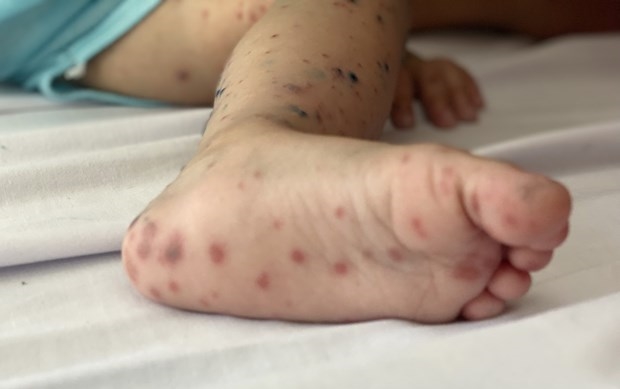Mr. Nguyen Hoang (Gia Vien district, Ninh Binh province) asked: I know that adults can also get hand, foot and mouth disease. Is hand, foot and mouth disease dangerous for adults and how to prevent it?
Regarding this issue, Master, Doctor Tran Thu Nguyet, Vietnam Institute of Applied Medicine, shared: Hand, foot and mouth disease is an acute viral infection, the main route of transmission is through the digestive tract, transmitted through direct contact with saliva, nasal secretions or broken blisters of a sick person. The disease often occurs in children, especially children under 5 years old. However, adults can also get hand, foot and mouth disease if their immune system is not strong enough to fight the virus that causes the disease. Thus, adults who are directly caring for sick children without taking preventive measures, or adults with weak immune systems who encounter an environment containing the virus that causes hand, foot and mouth disease, will be easily invaded by the virus, causing them to get sick.
 |
| Erythematous rash on the leg of a child with hand, foot and mouth disease. Photo: VNA |
The signs of hand, foot and mouth disease in adults are similar to those in children, but hand, foot and mouth disease symptoms in adults are often difficult to recognize and easily overlooked. Combined with the subjective mentality that "adults do not get hand, foot and mouth disease", hand, foot and mouth disease in adults is not detected and treated promptly, leaving serious consequences in some people. On the other hand, adults who care for and come into contact with sick people can carry the virus. If they do not prevent the disease properly, they themselves can also carry the disease and become a source of infection for children and family members.
The incubation period of hand, foot and mouth disease in adults is from 3 to 6 days; at the onset, the patient may have a mild fever and sore throat, which can be easily confused with other diseases. Initially, the patient's body will have small blisters, appearing in the mouth, hands, arms, feet, knees, thighs, buttocks, groin area... The blisters in the mouth are easily confused with canker sores, leading to delayed treatment, making the disease worse. The ulcers in the mouth are red ulcers or blister-like lesions, about 2-3mm in diameter, on the oral mucosa, cheeks, gums, tongue, when broken, they will form ulcers in the mouth and cause pain. However, in some cases, people with hand, foot and mouth disease do not have blisters, but instead only have a red rash, which can be easily confused with other diseases. In adults, there may be additional signs: cough, fever, runny nose, fatigue, vomiting, diarrhea, muscle aches, loss of appetite...
Most adults with the disease will recover after more than a week and some adults with weak body resistance, the disease will progress more seriously, such as: Lesions appear on the skin and mucous membranes; blisters burst to form ulcers, easily infected with pus. Hand, foot and mouth disease in adults, if not properly cared for and treated, can lead to dangerous complications such as: Neurological complications (encephalitis, meningitis, encephalomyelitis...), cardiovascular complications (myocarditis, acute pulmonary edema, heart failure, cardiovascular collapse...). These complications can be life-threatening, so it is necessary to see a doctor early for timely diagnosis and treatment.
There is currently no specific treatment and no vaccine to prevent hand, foot and mouth disease, so the focus is on detecting, treating correctly and preventing infection. Unlike children, hand, foot and mouth disease in adults often causes more itching, so you can use topical creams or anti-allergy medications when itching is severe. Care for blisters, rashes, ulcers: Disinfect ulcers to limit the ulceration process and secondary infection of ulcers with antiseptic solutions such as: 1% Methylene Blue, oral gel. Do not use antibiotics or any other drugs without a doctor's prescription because antibiotics are not effective for this viral infection. If the patient is self-treating at home, they can take Paracetamol when the fever is above 38°C.
Bathe daily with warm water, avoid scrubbing or rubbing the blisters to prevent them from breaking; you can dilute antiseptic solutions in the water for bathing. Use Methylene Blue or Betadine solution to dab on the blisters after bathing. Choose clothes that are soft, loose, and absorbent. Have a nutritious diet, avoid eating sour, salty, or spicy foods, and avoid foods that require a lot of chewing to help prevent mouth ulcers from being damaged. Eat soft, light foods for a few days, drink plenty of water, drink cool drinks, and rinse your mouth with clean water after each meal.
Adults need to proactively follow infection prevention measures for themselves, and at the same time not become a source of hand, foot and mouth disease for others. Wash hands regularly with soap and water or hand sanitizer, especially after contact with blisters or sores, after caring for sick people. Regularly clean surfaces and daily contact tools with disinfectant solutions containing chlorine, such as: school supplies, doorknobs, stair handrails, table or chair surfaces, floors... Practice eating cooked food and drinking boiled water, do not share eating utensils with sick people; avoid close contact (hugging, kissing) with family members to limit the spread of disease.
Health-related questions should be sent to the “Your Doctor” section, Economic -Social-Internal Affairs Editorial Department, People’s Army Newspaper, 8 Ly Nam De, Hang Ma, Hoan Kiem, Hanoi. Email: [email protected], [email protected]. Phone: 0243.8456735.
Source





































































































Comment (0)